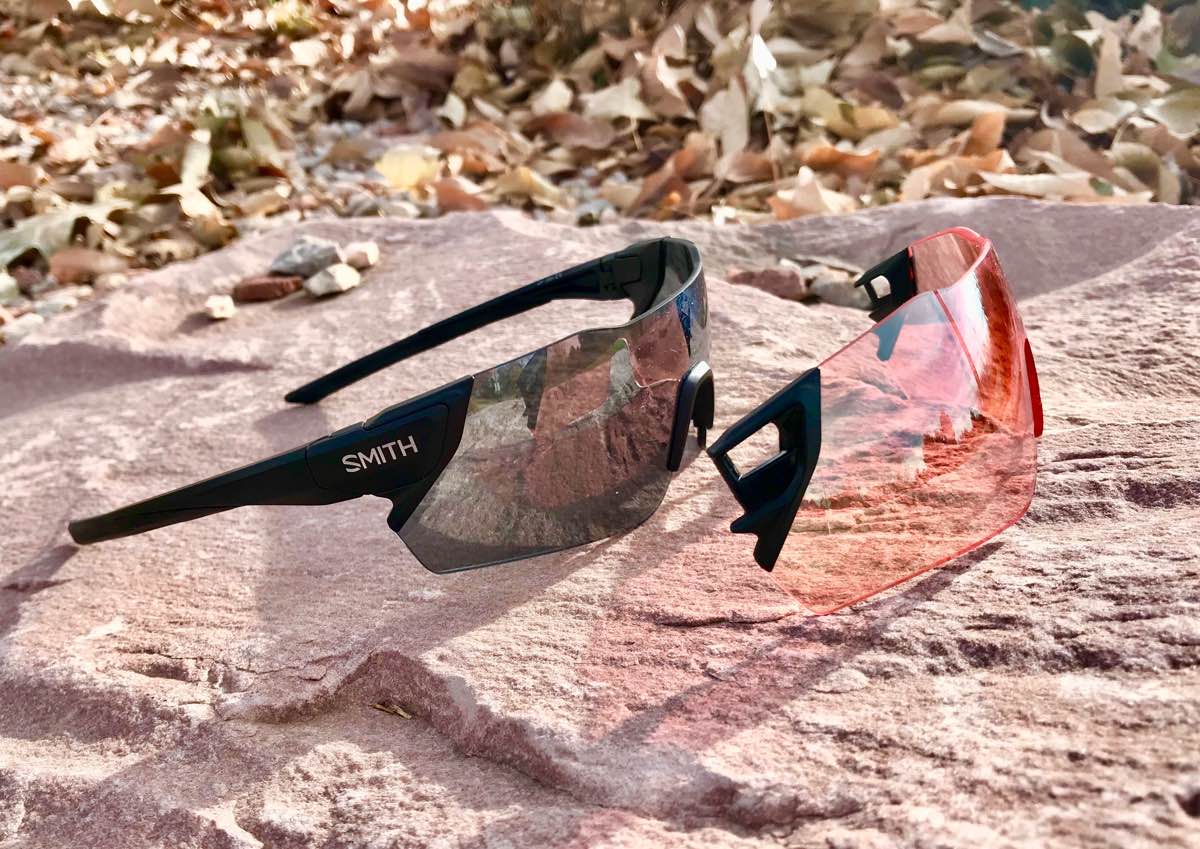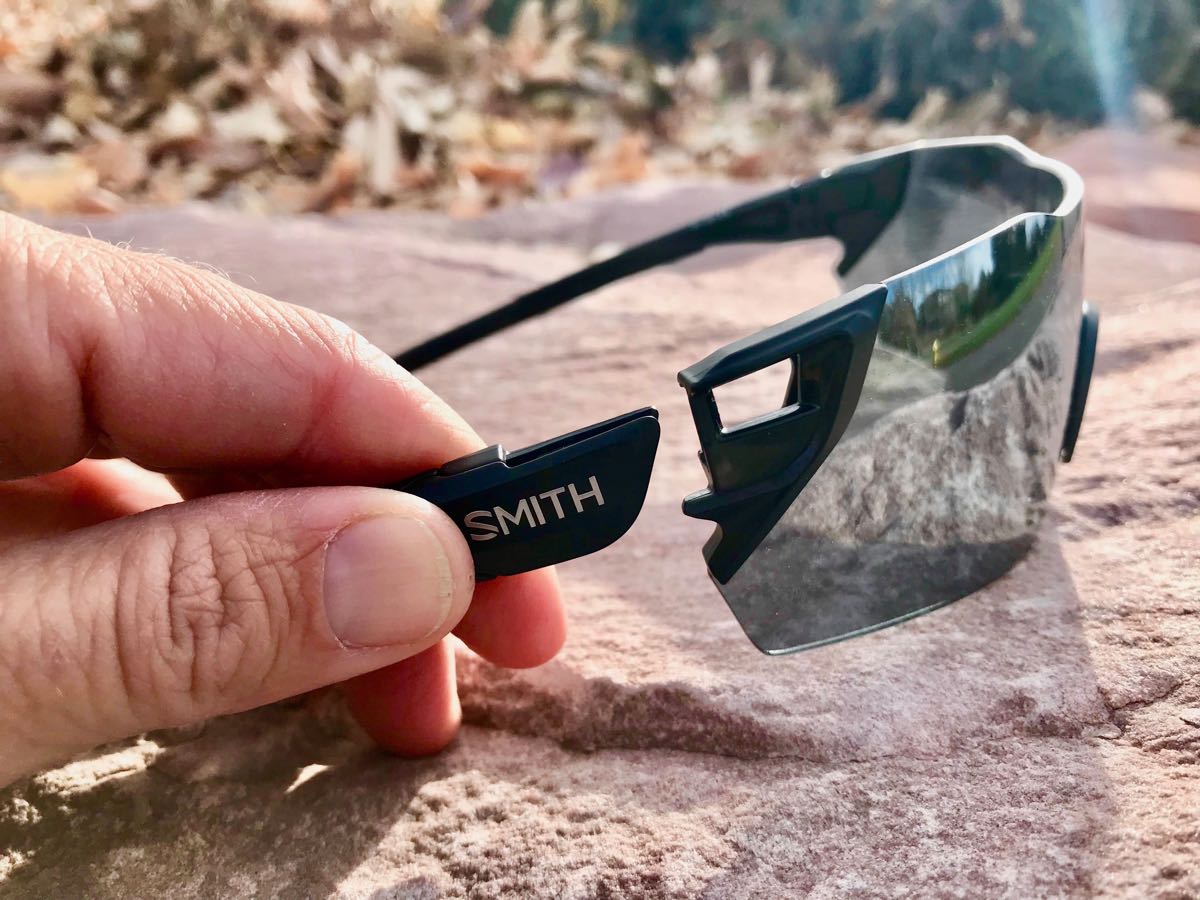Our Favorite Running Sunglasses
Check out our Best Running Sunglasses article to learn about our current favorite running sunglasses!
Smith Attack Sunglasses Review
It’s amazing how many technical-sunglasses options there are now compared to when I started running trails and ultramarathonss 22 years ago. I resisted purchasing them for awhile, figuring it was mostly the ‘fast’ people who needed them. But then I moved to Colorado and was truly ‘blinded by the light,’ and so I purchased my first pair which happened to be made by Smith Optics. I have a large head and low tolerance to pressure at my temples, so once I find a pair of running sunglasses I like, I wear them until they fall apart or disappear. In 20 years, I’ve had exactly three pairs in succession that I wear every time I run. My current pair of five years happens to be a different brand, so it was fun to get ‘back to my roots’ and test out the Smith Attack ($249) sunglasses with ChromaPop lenses.

The Smith Attack sunglasses. Shown is the Black Matte frame with ChromaPop Platinum (left) and Contrast Rose Flash lenses. All photos: iRunFar/Kristin Zosel
Smith Attack Technology
The frameless Smith Attack sunglasses feature impressive ChromaPop contrast-boosting lenses that come in non-polarized options of varying tints as well as the newest Smith MAG interchangeable lens technology which improves on the ease of the PivLock style.
- The main principle behind the ChromaPop technology is to enhance sharpness and clarity of vision on the trails by filtering the intersections of the blue, green, and red light perception. What this means functionally for me is that rock edges and roots stand out a bit more when enough (but not too much) light comes in through the lenses so that whether you’re under a canopy of trees or in full sun navigating cairn to cairn, you have improved visual clarity. I loved the fact that the lenses were not polarized as polarization doesn’t work for my vestibular system at all.
- The Smith MAG interchangeable technology lets you switch the arms off the lens by pressing down at the temple and detaching the magnetic clamp on the arm. Next, you slip the arm’s thin clamp onto the new lens. The magnetic ‘snap’ lets you know it’s secure. No rotation or torquing of the lens or any other aspect of the glasses is required. The nose piece slips easily off with a gentle pinch and snaps into place on the new lens in similar manner. All that’s left is to stow the unused lens and resume your run or ride.
Smith Attack Performance
I tested two lenses, the ChromaPop Contrast Rose Flash lens for lower-light conditions and the ChromaPop Platinum lens for bright conditions. In Colorado and the U.S. Desert Southwest, I preferred the Platinum lens because we are typically navigating technical trails in sunny, sunnier, and sunniest conditions. The Platinum lens does a great job of highlighting the contrast of the dusty rocks and debris all while keeping my eyes protected from the intense, high-altitude sun. Running back through the trees to the car, they still allow enough light in that I only had to pop them up on my head once when a big rainstorm darkened the area significantly. The lenses have a hydroleophobic coating which helps light rain and mist slide off effectively but is no match for a drenching storm. The lenses clean up really well from dirt, sweat, oils, and water with minimal smudges and streaks.
I tested the ChromaPop Contrast Rose Flash lens for the first time in the forest from the Hardrock 100’s Sherman aid station up into the Pole Creek drainage on a cloudy day and was impressed with the contrast provided with all the roots and rocks in that section. I also used the Rose lens on a variety of runs in the Colorado Front Range where the clouds parted to full sun and I’d be squinting more than I prefer even with a large-billed hat. This is when ideally I’d have had the Platinum lens along to switch to. The Rose lens would absolutely rock in places like western Oregon or anywhere else the clouds would be stable throughout the day or you’d remain in the trees for the bulk of the run. I’d also prefer the Rose lens with a dawn start or on an evening run as you race the light back to the car.

A front view of the Smith Attack sunglasses with the Matte Black frame and ChromaPop Contrast Rose Flash lens.

A side view of the Smith Attack sunglasses with the Matte Black frame and ChromaPop Contrast Rose Flash lens.
The biggest drawback to bringing along multiple lenses is that the protective carrying case is absolutely enormous. I’d never pack this case in my hydration pack. It’s relegated to a gigantic crew bag or the back of my car which means changing out lenses on the trail just isn’t going to happen. If you plan on doing that, invest in a much smaller case that will still accommodate the lenses. For this reason alone, I look forward to Smith developing a ‘photochromapop’ lens someday—auto-adjusting to the light level but still providing the enhanced contrast. Now that would be sweet!
The Smith MAG interchangeable technology featured in the Attack is pretty cool and allowed me to switch the lenses out and be ready to go in around 20 to 25 seconds. I had a few friends, children, and family members also try it to mimic an aid-station swap and no one had any difficulty after the first try. I’ve never been overly confident with lens switch-outs as I’m always afraid I’m going to break the lens or frame trying to perform the switch. This actually feels pretty solid in a variety of temperatures, however, so I can’t imagine a breakage occurring trail-side. Again, the nose piece has two settings you set with a slight pinch and a slide, and the arms slip into place with a magnetic ‘pop,’ so there’s no guessing whether it’s secure or not.
Smith Attack Fit
Smith bills these glasses as “medium fit/large coverage.” They have a significant wrap to them which ensures a large visual field that remains unobstructed by the lack of frames. They look ‘fast’ and ‘all business,’ like what you see at the pointy end of a professional cycling field. Though I’m not one who usually seeks this aesthetic from my glasses, the Attack sunnies fit my large head perfectly without any pressure through the temples, and the coverage is such that on blustery days, they feel like something between safety glasses and goggles—no dust gets in and no fogging occurs. On calm days with temperatures above 80 degrees Fahrenheit, I find a fair amount of sweat builds up under my eyes behind the large lens. When the humidity is higher, this did result in some fogging which sometimes wouldn’t clear on its own. I don’t live where humidity is high very often and it’s usually breezy where I run, but this might be more challenging at running speeds in hot/humid/calm climates.
Overall, I appreciate that the fit is snug without being tight anywhere because such glasses are hard for me to find. They’re a bit heavier than my typical running sunnies, but at the end of a several-hour run, my ears, nose, and sides of my head are still comfortable. They do not bounce or jostle on technical running terrain, nor do they move when I scrunch up my cheeks in a smile or grimace. I also find this fit effective when I switch to biking for the day. The arms integrate easily under my helmet, and the glasses really work well (and no fogging) at the higher speeds on a downhill. I tested them under my ski helmet as well and found it a comfortable option for warmer-weather skiing.
Smith Attack Overall Impressions
The Smith Attack sunglasses (and Attack Max for even more coverage) are high-end, multi-endurance-sport sunglasses designed for those who desire large coverage, significant wrap, and don’t mind switching out lenses to best fit the light conditions as they change during all-day endurance adventures. The lenses provide excellent visual acuity in a large range of light conditions, and there’s no easier interchangeable lens on the market. All this does come at a steep price, but when compared with similar offerings from other premium companies, the Attack holds its own.
Call for Comments (from Meghan)
- Have you worn the Smith Attack sunglasses? If so, what is your opinion on them overall?
- Which ChromoPop lenses have you tried and how do they perform for you?
- What do you think about the updates Smith has made with the Smith MAG technology which is supposed to provide easier lens interchangeability?
[Editor’s Note: If you’re affiliated (i.e., an employee, ambassador, etc.) with a shoe brand, please share your relation in each of your comments on this article. Thanks!]




